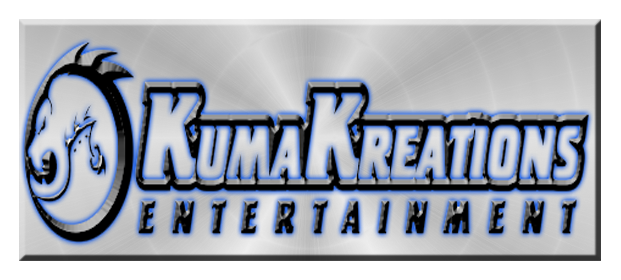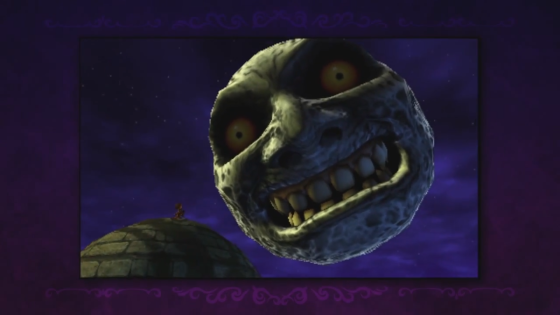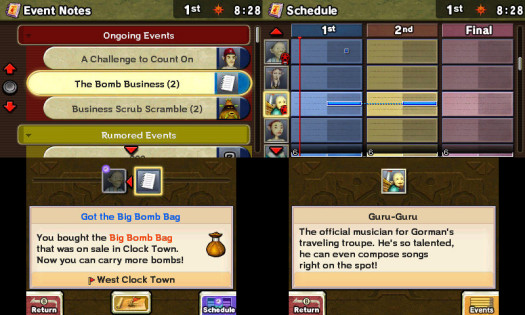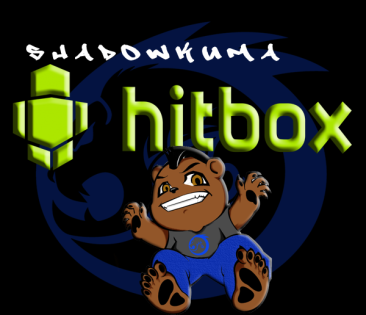You’ve met with a terrible fate, haven’t you?
Majora’s Mask is not your typical Zelda game. It was released at a time when Nintendo wanted to make some changes to the successful franchise. One of these changes was to make a game that would appeal to an older audience than their previous games. It is also perhaps the most daring game in the franchise as it completely rejects the standard blueprint that Zelda games usually follow. The result is a game that is darker, more difficult, and that introduces some brand new mechanics to the franchise.
Link, I don’t think we’re in Hyrule anymore.
The game is a direct sequel to Ocarina of Time and reunites us with young Link as he rides through the Lost Woods in search of a dear friend. He is ambushed by an imp who is wearing a strange mask. The Skull Kid manages to steal both Link’s horse and Ocarina. After a wild chase through the forest, Link finds himself lost and confused in the land of Termina. A curse traps him in the form of a Deku Scrub. He also learns that Skull Kid intends to destroy all of Termina by summoning the moon. Link has 3 days to break his curse and stop the moon from crashing down on the unknowing inhabitants.
The first thing that you notice when playing Majora’s Mask is that it’s not a game that welcomes new players. The developers made this game with Ocarina of Time veterans in mind and wanted to make a new challenge for them. Where OoT was a game that helped you get started and supplied plenty of hints on how to proceed, Majora’s Mask has the opposite approach. It does little to nothing to help you. It is as if the game is challenging you and asking if you have what it takes to beat it. While the difficulty level has been toned down somewhat (more on that later) it is still a challenging game and not the best game to start with if you are new to the Zelda franchise. It will require you to explore the world and take time to find hints in NPC dialogues. A familiarity with the game mechanics will be a big help. The Stone Temple still stands as one of the hardest dungeons in the Zelda franchise to date. However, the feeling you get when you finally figure out what to do or beat that tricky puzzle is fantastic.
The game revolves a lot around masks, as the title suggests. There are numerous masks to be collected and they are all connected various quests and events in the game. The most important of these is the masks that let Link change his appearance to a new shape. These masks contain the spirit of a dead being, and putting on the mask results in a sort of spirit possession that allows Link to physically appear as that being. Each being has their own set of skills that can be used to tackle puzzles and other obstacles. While having Link shape shift is not entirely new to the series, never before has a Zelda game had it as a core mechanic. It brings a new level of challenge to the game as you now have to approach each obstacle from different angles. If you can’t see a solution using Link and his skills, how could a different shape be able to solve it? Combining shapes in both puzzles and combat makes a fantastic adventure, and I’m hoping that these mechanics will make an appearance in later Zelda titles as well.
Another element that adds to the challenge is the 3 day time limit. The ingame clock is permanently visible on the game screen, a constant reminder that your time is limited and always counting down towards the impending doom. While Link has the ability to turn back time, it is no reason to relax. When you warp back in time you lose most of the items in your inventory (masks and weapons remain) as well as progress on sidequests and dungeons. The game shows no mercy when you reach the final hours of the final day. Do you press on and try to defeat that boss at the last minute or do you travel back to the first day?
Link relives the same 3 days over and over while gaining new skills and equipment to help him save Termina. As he explores the world he meets new people and get involved in their lives. They are completely unaware of the time-loop they are trapped in. The implementation of these characters and their writing is one of the areas where this game truly shines. In previous Zelda games, the NPC’s have always been very static. If you help the young woman gathering up her runaway chickens and collect the reward, the chickens will still be runaways as you re-enter the area later. In that way, you don’t feel that your actions have any lasting impact on the world. In Majora’s Mask, every character in Clock Town have their own storylines. They move around town as time goes by. As a result, Clock Town feels like it alive and that all characters have their own lives and connections to each other. It is a great experience to interact with these characters and see how their stories evolve during the three days. Most of these characters will also be connected to side quests. These sidequest are not your typical ‘find the lost chickens’ variety, but are directly connected to what the characters are going through. You get involved with their stories and help them sort out issues that are personal to them. All these quests have a solid story and it’s interesting to see how your involvement can influence their lives.
Out with the old, in with the new.
If you played the 3D version of Ocarina of Time, you know that the developers did a great job of keeping the game very similar to the original while making a few changes to optimize the game for a new format. In Majora’s Mask the developers have put a lot of effort into staying true to the N64 version, but the changes are more noticeable. Most of these changes are made in an effort to make the game more compatible with a handheld style of gaming. Minor changes includes a new fishing game, making some areas easier to navigate, and moving certain items to new places. Other changes are more substantial.
While the original version of the game let it be up to the player to remember most of the information in the game, the 3DS version makes things a bit easier to accommodate for shorter gaming sessions on the go. The most important change related to this is the overhaul of the Bomber’s Notebook. This book is accessible at any time on the bottom screen and collects information about characters and their schedules. It also shows you exactly what times during the day you should approach them to initiate sidequests or get new information. The notebook has been overhauled and is now a lot more accessible. It contains more information on every sidequest, making it a lot easier to figure out where you left off and what to do if you need to repeat a step.
A new feature that helps in your time management is the ability to warp to a specific hour in the 3 day cycle. In the original game you could only travel back to the beginning of the first day. This could result in a lot of waiting if you needed to do a quest on the second day. Now, that frustrating wait is no longer a problem and, combined with the new Bomber’s Notebook, creates a much better flow in the gameplay.
Saving has also been greatly improved. In the N64 version you could only save the game by traveling back to the first day. If you had to leave your console while working on a quest on the third day you had no other choice than to lose progress by turning back time and then save. The 3DS version has a number of save points scattered around Termina. You can save at these at any time. This is a crucial change that makes the game a lot better suited for a handheld console.
The bosses in the game have also seen some changes, for better and for worse. The most obvious change is the addition of big yellow weak points. Part of the challenge of the original bosses was that they didn’t have any obvious areas that you needed to aim for. Because of that it became a challenge to try out different methods in order to find the strategy that revealed the weakness of the boss. In the 3D version the yellow glaring eyeball makes you think ‘Oh, I see.’ from the first introduction of the boss. While I understand that Nintendo wanted to make the game more accessible, it shouldn’t mean that they make encounters easy. I feel like a lot of the challenge in defeating the bosses has been removed as a result, and the great feeling of victory when beating them is completely gone. The good news is that the revamped bosses sometimes allow for a more diverse approach that allows you to use Link’s different transformations more actively to defeat them. The boss in the first temple, for example, now allows for a strategy that lets you use both Link in his human form and Deku Scrub form to take him down. Changing forms in battle and combining their different skills to take down the main bosses is great fun in addition to creating a new layer of strategy to each encounter. Each boss can also be defeated multiple times by revisiting the temples, so you are free to have a try at different approaches if you want to.
Despite a lot of good changes, there are some issues that remain. The most notable being the ingame camera. The camera was an issue in the original Majora’s Mask in that it tended make it hard to do platforming sequences or some fights because it spun around and made it hard to see what you were doing. While the camera had a nice overhaul in Ocarina of Time 3D, it seems like Nintendo made no effort to improve it in this game. Nintendo has made new camera controls to make the experience better, but these controls are only available if you have the New 3DS with the new C-Stick or if you have a Circle Pad attached to your 3DS. For people like me who are playing on the original 3DS without the Circle Pad, the camera is the same spastic nightmare that it was in the original. While it is good that Nintendo has put in effort to fix the camera it is annoying that this improvement is reserved for people who can afford the newest hardware. The rest of us will get the bad camera us poor peasants deserve.
When the camera works, or you enter the first person view, you can explore a beautiful upgraded version of Termina. The graphics in Ocarina of Time 3D were gorgeous. They stayed true to the original game while lifting the game up to modern standards. Majora’s Mask 3D is just as good looking, if not even a little better. I found myself amazed on several occasions by how fantastic the world looked. The whole game has been rebuilt from ground up. While the areas and characters look strikingly similar to the original versions, they have a lot more detail and much better textures. My only gripe with the update is that it does feel a bit ‘brighter’. Majora’s Mask was always a dark game in terms of themes and story, but the world felt dark as well. The colors were darker, as if a shadow was constantly looming over Termina. In the 3D version there are areas that feel like they have a brighter palette, and some of the gloom of the game has been toned down. This is not necessarily a bad thing as it helps making the graphics clearer and better, but I do miss the feeling of a darker world a little bit.
Conclusion
Majora’s Mask is a fantastic and challenging game. It stands as a brave entry in the Zelda series that dares to push the franchise in a brand new direction. While being very different from your typical Zelda game, it also feels familiar enough to be a true sequel in the series. The game is difficult and challenges even veterans of the franchise with hard puzzles and new gameplay mechanics. The world feels dynamic and alive thanks to the three day cycle. As the days pass, every NPC follows their own schedules and storylines that make the world constantly evolving around you. The game has a lot of sidequests that have their own rich stories. Several changes has been made to the game to make it flow better and to accommodate for players who will be playing on the go. At the same time it improves on some of the weaknesses of the first version of the game. The result is a remake that plays better in almost every aspect, even if it feels a bit easier on some points. Despite these changes, I would not recommend Majora’s Mask to new Zelda players as it is made as a challenge to veterans of the series. However, if you are a fan of Zelda or action adventure games and are up for the challenge, I highly recommend picking this game up. The game stands as an unique experience in the entire genre and I have not played anything else like it.






